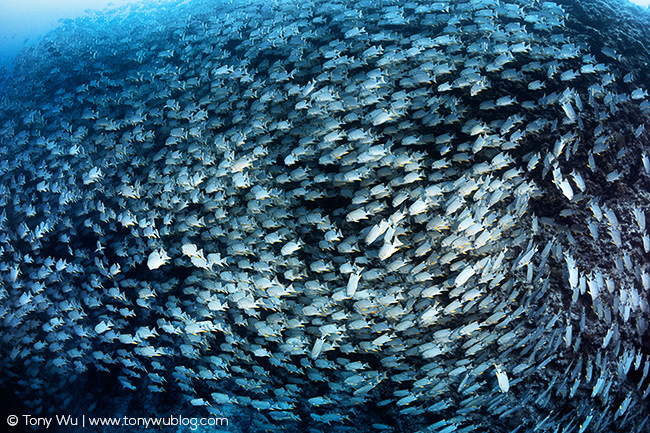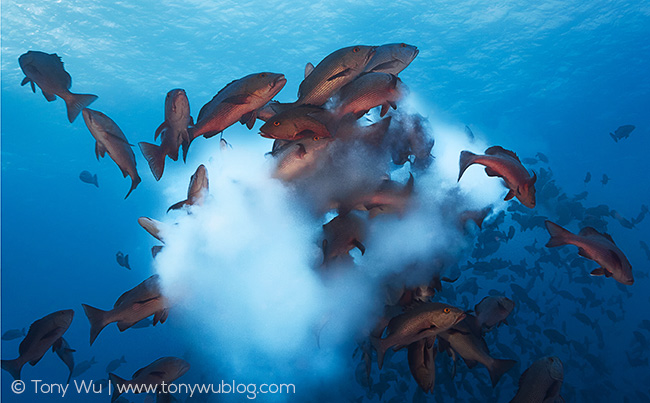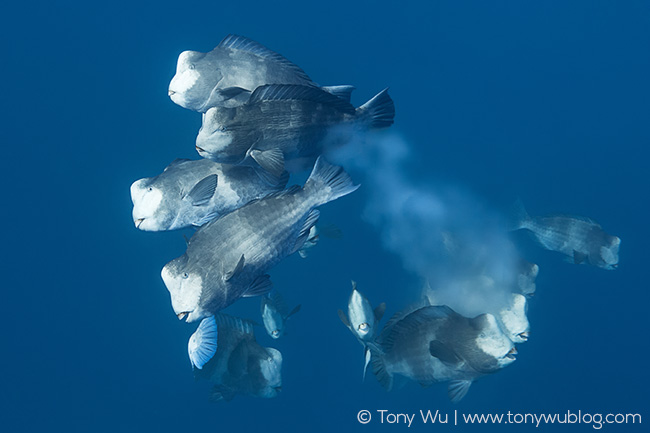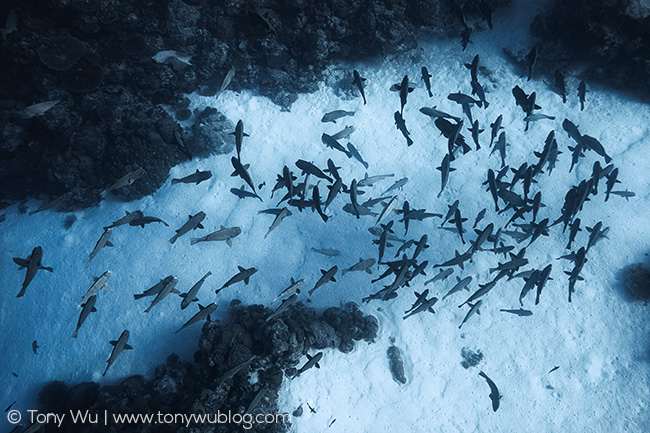Note: This article originally appeared in the September 2015 issue of Outdoor Photographer magazine, and is viewable on the outdoorphotographer.com website. I am reproducing it here for my own records, and because I think the message bears repeating.
Why do you take photos?
The answer is different for everyone, but the reason I tossed aside a career in finance to devote my life to photography isn't just so I can take pretty pictures. There are lots of people who can do that. Photography, for me, is the process of coming across something of interest, researching it, understanding it, obsessing about it and internalizing the unique aspects of my chosen subject to figure out what makes it special, worthy of devoting days, months, sometimes years of my life to. As an example, here's how I became obsessed with how fish reproduce.

The example I've set out here relates to spawning aggregations of marine fish, but this is how I approach all potential photography projects—ars gratia scientiae, as the tagline on my homepage states—meaning, art for the sake of knowledge, in Latin.
Chances are, you've never thought about fish sex. Most normal people haven't. I mean, how stimulating can it possibly be to contemplate the mechanics of cold-blooded marine life reproduction? Ugh, right?
Well, I was normal (in this sense) until 2011, when fish sex became an obsession, an all-consuming desire to plunge myself into the midst of procreating piscines. Bear with me, and I'll explain the what-why-how-when-and-where behind this life-altering turn of events for me.
First, let's set the scene, so you understand what I'm talking about. Picture the ocean, just before sunrise. Imagine that you're submerged 50 feet or so beneath the waves, immersed in dark, moody waters on the precipice of illumination by the first light of day. You kick and fin, inhaling from your life-sustaining tank of compressed air, annoyed that the unrelenting current makes it difficult for you to keep pace.
But that current is critical. Thousands of fish—coming together from who knows how far and deep—are gathered in front of you, in part, because the tidal flow will carry their soon-to-be progeny to relative safety, away from hungry mouths, to a place where fertilized eggs have time to grow, freedom to develop from amorphous blobs of protoplasm into tiny fish larvae.
You watch. You wait. You scan for signs of impending activity. There's a quick glance at your gauges to make a mental note of how much air and, hence, time, you have left. Then it happens.
A single fertile female breaks from the swarm. Compelled by genetic imperative, she accelerates toward the surface with determined urgency, a pack of males in hot pursuit. At the zenith of her spawning arc, the female pivots and bolts for the deep, releasing a billow of eggs. Hormone-laden males track her every move and—sensing opportunity—release streams of sperm at the critical moment, hoping that theirs will be the seed that completes the reproductive cycle, connecting this generation to the future. Gametes coalesce into streaks of white that linger in the water like contrails from passing jets, a visual metaphor for life's perpetual struggle to survive.

In the seconds that it has taken you to watch this drama unfold, dozens—no, hundreds—of other females have let loose their own procreative ambitions, each pursued by a cluster of single-minded suitors. Throngs of fish swirl and mix in frenzied chaos. Clouds of sperm and eggs obscure visibility like the densest of London fog. Sex-crazed fish surge through milky-white haze. You duck to avert collision.
Peak action spans 30 minutes or more, you doing your level best to keep up, camera in hand, trying to select and frame order out of mayhem. Surprise encounters with bull sharks or other tooth-laden predators ripping through opaque waters spike your heart rate, your adrenalin. This is one of nature's greatest events, one that few have witnessed.
Now that you have an idea of what it's like to be in the middle of a massive fish-spawning aggregation, let me share a bit of background about how I ended up devoting so much time to photographing these spectacles.
It all started in early 2011, when friends told me about a gathering of thousands of bumphead parrotfish (Bolbometopon muricatum) in Palau, discovered by a Japanese dive shop named Blue Marlin.
Whenever I take an interest in a specific animal or event with photographic potential, I start by doing some basic research and background reading. My aim is to figure out what's known, what's not, and what aspects of the relevant animal or phenomenon, if any, have already been documented with high-quality photographs. The result of this initial process determines whether I pursue the matter further, or simply move on, having satisfied my curiosity.
These days, the Internet is my first resource; it's the largest library ever assembled. If knowledge is power, access to the Internet is as close to omnipotence as I'll ever get. I often invest days or weeks collecting and reading available information. After perusing online resources, I move on to books, periodicals and published scientific papers, taking notes, comparing sources, familiarizing myself with current knowledge. Finally, I reach out to researchers or experienced specialists with questions I can't answer myself.
The process is important. Why? Because there's little to be gained by sending questions willy-nilly to experts.
Think of it this way: If you're the world's foremost authority on a given subject, you're probably fully occupied researching, writing, teaching, etc. If you come across an insightful inquiry that shows that the person asking the question has done a lot of background work to understand and appreciate your field, you might set aside time and effort to respond. If it's a basic question that can be answered with a simple search engine query though, why waste your time? Right?
Not everyone I contact responds, but many people do. Over time, if I demonstrate consistent interest and provide constructive feedback from what I observe in the field, many initial email queries become long-term correspondences. A few develop into treasured friendships.
In the case of bumphead parrotfish, I soon learned that a massive spawning aggregation like the one I described above had never been documented. Not by divers, not by scientists. In the course of my initial research, I came across photographs of bumphead spawning, but none that I felt was of sufficient quality and visual impact to do justice to such a breathtaking spectacle. No documented precedent; check. No stunning images; check. The prospect of photographing something new, particularly a phenomenon of such visual scale and impact, proved irresistible, which is how I found myself headed to Palau in early 2012.
If you're not familiar with this Pacific island nation, it has been a hotspot for recreational scuba diving since the early 1970s. Hundreds of thousands of people from all over the world have visited the islands to plunge into idyllic tropical waters and marvel at marine life. Despite the destination's popularity and the plethora of dive operators in Palau, for decades no one noticed that there was a monthly gathering of thousands of bumphead parrotfish.

For perspective, bumpheads are large fish, with adults weighing up to 100 pounds each. In other words, we're not talking about small, easily overlooked animals. With several thousand fish taking part in the group spawning, we're talking about monthly aquatic parties involving tons of big fish!
My friends first noticed in 2009 that there was an ebb and flow to the appearance of bumpheads. Over the next two years, they put in many hours observing the fish, recording data and identifying patterns in the spawning area. By the time I visited in 2012, they had worked out the mechanics of where and when the fish gather. This allowed me to concentrate on watching behavior and figuring out how to capture the best images possible—no small challenge.
First, since there was no precedent for observing a spawning aggregation involving so many fish of this species, it wasn't like I could glean much about what to do or how to anticipate spawning behavior from a book or research paper.
Next, even though my friends had worked out the fish's schedule, it was one thing to see the bumpheads, another altogether to photograph them in a way that conveyed the scale, beauty and biological importance of the event. Working in extremely low light, with fast-moving subjects, underwater—now there's a photographic challenge if there ever was one.
And, finally, fish live in water. People don't. Though I'm a decent swimmer and experienced diver, the fish left me in their wake during my first few attempts to photograph their aquatic orgies. I had to up my game, so to speak, in order to get into the thick of the action. I trained to swim faster, for longer, with less air consumption, than I ever had.

All told, I spent 45 days in Palau during 2012, divided over three visits, photographing mass reproduction of bumphead parrotfish. I probably spent the same or more time reading and training to prepare myself. I made a lot of mistakes (i.e., I failed miserably at first), but taken together, my initial background research, extensive consultation with friends in Palau who had already done a lot of legwork and focus on physical training stacked the odds of success in my favor.
Since my initial foray with the bumpheads, I've photographed spawning of several more species in Palau: twinspot snappers (Lutjanus bohar); sailfin sea bream (Symphorichthys spilurus); and Napoleon wrasse (Cheilinus undulatus). I'll be traveling to Palau again to continue this project. In the meantime, I'm doing more background reading, sharing information with scientists who specialize in spawning aggregation, and relying on friends in Palau for updates.
I do my best to apply the discipline and thought process of science to my projects, with the goal of creating photographs that are both aesthetically pleasing and imbued with meaning. Though often fraught with difficulties and obstacles, this path has proven rewarding. I'm forever reading, studying, trying to learn new skills and figure out solutions to technical problems—24 hours a day, 365 days a year, isn't nearly enough time.
I've met a lot of fascinating people, experts in their fields, the best people from whom to learn. I'm fortunate to count many as valued friends. Sometimes, I'm even able to give back to them, providing information, notes from first-hand observation and photographs to help impart life to abstract text. Since many of the subjects and situations I choose demand a high degree of physical exertion, I've also had to stay fit, a nice fringe benefit. And, finally, on those rare, rewarding occasions when everything comes together, I succeed in creating aesthetically pleasing images that also have meaning and purpose beyond visual gratification.
Let me conclude with one parting thought. My point in writing this article isn't to suggest that my particular philosophy is the one and only raison d'être for nature photography. It's just what works for me. What I'm saying is this: Think of the billions and billions of people who have ever lived. How many had the time, education, freedom, wealth, technology and opportunity to create and share beautiful images of the world?
Those of us fortunate enough to be in this category represent a fraction of humanity, less than a rounding error in percentage terms. A very small, tremendously privileged rounding error. To paraphrase Uncle Ben from the Spiderman saga: With great power comes great responsibility.